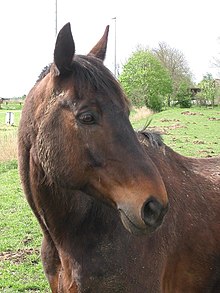Change of coat
The shedding of hair or feathers of many mammals or birds is referred to as a change of coat , hair change , hardening or moulting , which mostly happens seasonally, whereby the properties and color of the fur or the plumage are adapted to the seasonal conditions.
General
Almost all mammals of temperate and polar latitudes adapt the structure of their fur to the conditions of the seasons in order to protect themselves from the cold or also as a changed camouflage color against predators or prey. When a hair grows out, it loosens from its roots. The next time the coat changes, it is slowly displaced by the new hair that grows back. Different hairs are formed in predators. Although the number of hairs always remains the same, winter hair differs from summer hair in that it is longer and thicker. The winter coat can consist of numerous curled woolen hairs that form a standing layer of air and thus prevent the body from rapidly losing heat. A dense, short undercoat, which is placed under the coarse outer fur if necessary, is also possible. Hormonal changes are the trigger for the coat change.
Different coat changes according to animal species
Noticeable examples of fur changes are animals that camouflage themselves with a white fur in the snowy winter . This characteristic has developed independently of one another in very different animal groups, e.g. B. in ermine , arctic fox and mountain hare .
The hair change does not start on all parts of the body at the same time, it takes place in a sequence characteristic of each species.
While hair changes twice in temperate climates, in spring and autumn, some arctic animals such as reindeer , polar bears and seals change their fur only once a year. In the case of seals, this happens when they are suckling the young and when they are out of the water on land or on the ice. The change takes place particularly quickly here. The hair loosens in whole shreds and the new fur grows back quickly. Even animals that hibernate usually only have a single hair change, including badgers , dormice , marmots and others. Mammals that spend significant amounts of time in the water, such as otters , giant otters , sea otters , but also beavers and nutria do not have a seasonal hair change. Because of the heat-removing effect of the water, they constantly need a thick coat of hair, which is why individual hairs are constantly changing.
In the case of the mole, we even know that the coat changes three times a year. Between the two seasonal changes, there is still a summer "intermediate hair", in both sexes and in all age groups.
Squirrels lose a lot of top hair and even their ear brushes in summer. In autumn and winter their fur has grown back and is shiny. The hair on the ears is also sprouting again.
The change of coat is particularly evident in domestic horses, especially if they live in an open stable or robust housing and are not covered, i.e. are exposed to the weather.
Often the youth clothing of fur-bearing animals differs considerably in color and structure from the adult animals, occasionally even with intermediate stages, for example in some seal species (names according to age are whitecoat and blueback, in addition the coat of adult animals. See also seal fur ).
Miscellaneous
The change of coat sometimes leads to problems for those allergic to animal hair , as pets such as dogs , cats or horses also change their coat.
Web links
supporting documents
- ↑ a b c d e Christian Franke / Johanna Kroll: Jury Fränkel ’s Rauchwaren-Handbuch 1988/89 . 10. revised and supplemented new edition, Rifra-Verlag Murrhardt, pp. 352–354.
- ^ Encyclopedia of Nature P. 134 Bertelsmann Lexikon Verlag GmbH Gütersloh / Munich 2001 ISBN 3-572-01284-8

